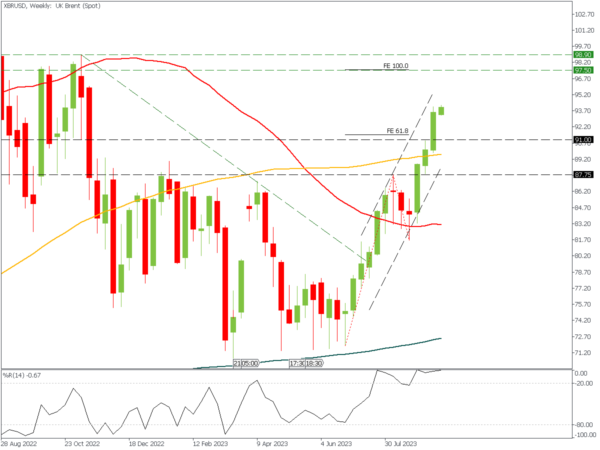The past several weeks have been a real triumph for the bulls in the oil market. The Brent spot price grew by 8.5% during the last month.
The energy market is currently becoming especially important for both blocs of countries. BRICS+ countries represent the Eastern bloc, while the Western bloc is G7 countries. A severe confrontation over price continues. The oil market is the key to the future global geopolitical and economic configuration.
Prerequisites for a price war in the oil market
According to money supply ratios, 80% of all money entering the American system occurred between 2020 and 2023. All available channels were used to pump in liquidity: QE, Helicopter Money, and low rates. The situation in G7 countries was more or less controlled in 2021, with an inflation level of 5%. By February 2022 (the beginning of the Russia-Ukraine conflict), the CPI in the States reached 7.5%. The Fed-targeted Personal Consumption Expenditure (PCE) approached 6%. However, by the time of the price shock in the oil market, the Fed had still not begun the cycle of monetary policy tightening, leaving the real rate in a deeply negative zone.
The oil market’s price shock, provoked by the conflict in Ukraine, required the Fed to make tough decisions. Firstly, the FOMC began to raise the rate quite aggressively – the increase step at each meeting was at least 50 bp. Secondly, in April 2022, the Fed balance sheet began to decline (QT) for the first time in quite a long time.
However, this was not enough. Since full control over inflation was possible only if oil prices were controlled.
G7 countries win the first round
The first thing the United States did after the start of the conflict in Ukraine was to cut Russia from the European energy market. Although this was done to the detriment of the national interests of the allies, the United States became the largest beneficiary of the process. The American energy sector made a significant breakthrough. By October 2022, the S&P Energy sector had almost reached its 2014 historical highs, testing 724.74 points.
To solve this problem, the United States significantly increased oil production (up to 12.8 million barrels per day) and continued to sell oil from its strategic reserves. Strategic oil reserves in the United States over the past two years (i.e., since the COVID crisis) have decreased from 635 million to 350 million barrels. This means that by releasing liquidity into the markets, the States simultaneously began active actions in the energy market, preventing price growth. Thus, monetary control in 2020–2022 gradually passed into energy control. By the way, strategic reserves are strategic because they serve to solve longer-term US goals. Commercial reserves are for short-term tactical use.
In 2023, this US control of the energy market was strengthened by the inclusion of WTI Midland in the Brent DTD, thus gradually squeezing out the British grade of oil from key grades in the derivatives market.
The United States expected another energy shock to occur but did not think this shock would be so strong. Otherwise, the FOMC would likely have begun a tightening cycle before the Russian-Ukrainian conflict started.
Then, the United States tried to increase oil production by reaching agreements with the largest oil producers, Iran (9th in the world) and Venezuela (20th). From January to July 2023, oil production in Iran increased from 2.5 million barrels per day to 2.8 million barrels (an increase of 12%) in Venezuela from 732 thousand barrels to 810 thousand barrels.
As a result, oil prices dropped below $80 per barrel in the second half of 2022 and the first half of 2023. The correction in the energy market with the simultaneous monetary policy tightening decreased consumer inflation by 500 bp – 8.2% to 3.2%.
The opening of China that never took place this year was a gift for oil-consuming countries. The Chinese economy reached a plateau and did not generate additional impetus for growth in oil prices.
OPEC+ Response
The countries of the Eastern bloc responded by reducing oil production. Saudi Arabia reduced production to 9 million barrels per day (in 2022, the country produced about 11 million), and Russia reduced production not so significantly – to 10 million barrels (production in July 2022 was 10.3 million). According to OPEC’s latest report, the cartel’s members cut production by 836 thousand barrels from June to July this year – to 27.3 million per day.
Their actions pushed the price up from $74 to $93 per barrel. This will later lead to higher inflation in the consumer countries and start a new cycle of inflationary pressure. Geopolitical tensions are likely to rise.
Technical Analysis
The price broke several resistance levels.
At first, it broke $87.75 and moved to $91. The bears gave up this level, too. The nearest resistance level is at $97.50.
According to the Elliott wave theory, the movement up may be a third impulse wave. It means that after the correction, the asset may overcome $97.50 and move directly to $100.
Let’s sum up:
- The price of oil and control over it has always been the main goal in the confrontation between countries on the world stage. This goal is becoming even more important, given the almost complete exhaustion of resources to control inflation (rates in developed countries have been kept at a high level for quite a long time; SPR in the United States has decreased significantly).
- Oil prices will most likely continue to rise. Consequently, it becomes impossible for the developed economies to switch to monetary easing fast – rates will remain high for a long time.
- Geopolitical risks are on the rise, so safe-haven allocations should increase.
- Market volatility will increase, and speculative strategies may be more attractive in the medium term than the classic “buy and hold” approach.















